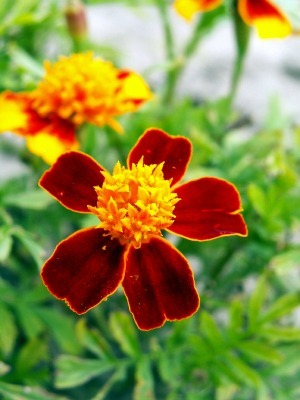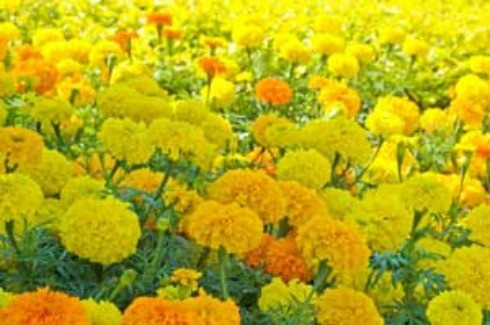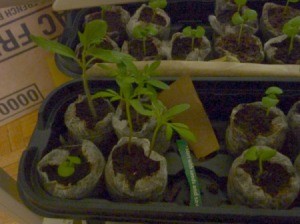

| Botanical Name: |
| Tagetes |
| Life Cycle: |
| annual |
| Planting Time: |
| spring |
| Height: |
| 6" to 36" |
| Exposure: |
| full sun |
| Soil: |
| average, well-drained soil |
| Hardiness: |
| n/a |
| Bloom Time: |
| year-round depending on variety and zone |
| Flower: |
| yellow, gold, orange, maroon and crimson; solid or bi-colored, single or double flowers |
| Foliage: |
| light to dark green |
| Propagation: |
| seeds, self-sowing |
| Suggested Use: |
| beds, borders, mass plantings, edging, containers, planters, paths and walkways |
| Growing Hints: |
| Start with inexpensive nursery transplants or seeds sown directly into the ground in the spring. You can also start seeds indoors 6 to 8 weeks before the last frost date. Advertisement |
| Interesting Facts: |
| Marigolds possess natural compounds useful for repelling nematodes in the garden, especially African varieties. Several varieties are also widely used for their culinary and herbal properties (mostly for tea) in many Latin American countries. |

Hardiness Zone: 6a
Peggy from Springboro, OH
It sounds to me like slugs or snails have an appetite for your marigolds. They attack at night, usually eating the lower leaves first. The next day, you wake up to holey flowers and ragged leaves, or worse, nothing but a row of stems and a silvery-gray trail of slime on the ground where they have glided up to your plants.
The good news is that there are several easy and economical ways to effectively control the damage caused by slugs and snails.
Handpicking: This isn't the most appealing method, but it works. To spot them, grab a flashlight and head out to your marigold patch for a snail safari about an hour after sunset.
Setting traps: Snails and slugs love cool, moist places-especially to lay their eggs-so use this information to your advantage. Flip over some old flowerpots on the ground around the garden. Leave one side propped up just slightly to act as an entrance. Half an intact grapefruit or orange rind (minus the fruit) will work well, too. Check these traps daily and discard any snails and slugs you find hiding there.
Snails and slugs like beer. I've used this method myself after snails and slugs discovered some of my hostas, and I can verify that it works. Place a shallow container like a saucer or even a cut down yogurt container into the ground so that the top is at soil level. Fill the container with about an inch of stale beer (there's no need to waste the good stuff). Slugs and snails will stop by for a cold one, crawl into the container and die a happy death. Check traps daily and refill as needed.
Constructing Barriers: Slugs and snails avoid crawling over sharp surfaces. Create a physical barrier next to the base of your plants with crushed eggshells, dichotomous earth, wood ash, or coarse grade saw dust.
Snails and slugs will also avoid crawling over copper because it gives them a slight electric shock. Construct barriers from copper pipes or strips available at local hardware stores.
Cleaning up debris: Snails and slugs love to take refuge under garden debris from the hot afternoon sun. Clean up leaves, old boards, rocks, and old pots to reduce daytime hiding places, and avoid using mulch more than 3 inches deep.
Watering during the day: Because snails and slugs love a moist, humid environment, water your plants in the morning to allow time for leaves and stems to dry before nightfall.
Good luck!
Ellen
Slugs! Slugs are eating your marigolds at night. It is a very well-known problem. I remember when I was growing up, my mother used to make little moats/trenches around her marigold beds. Then she filled the trenches with beer. This is a very common solution for the slug problem, even though it sounds crazy. I found an explanation for you that might explain it better than I can. Go to: www.advancingwomen.com/
Good Luck!
The other possibility is pill bugs and/or sow bugs since I have caught them happily eating my marigolds.
insected.arizona.edu/
www.pestcontrolcanada.com/
If it is slugs, I have also read on this web site that crushed egg shells will stop them.
This is slugs, snails or cut worms. Sow or pill bugs ar decomposers - they only eat dead material. Put a strip of copper wire to keep slugs/snails out - but this can be expensive. There are good (and fairly non toxic products like Sluggo that can help).
You could put little paper cups on top of your seedlings at night. I have actually used the clear plastic cups as miniature green houses for growing from seed.
IVE ALSO HEARD IF YYOU WATER YOUR PLANTS LATER IN THE DAY IT WILL CAUSE THE SLUGS TO BE WORSE.BEST TIME TO WATER PLANTS IS IN THE MIDDLE OF MORN BEFORE IT GETS TO HOT.
Some garden experts feel that we rely too much on marigolds to fill in our flower beds. I disagree. Marigolds are easy to grow, and their cheerful flowers offer a summer-long burst of color anywhere you plant them.
Picture of Marigolds in front of the creek that runs through our property. Marigolds are one of the few flowers that the deer won't eat up!
These are zinnias and marigolds! I dislike the smell of marigolds, but I love the way they are sooo bright!
What are these mushrooms on the base of my marigold? They grow fast and seem to explode onto the plant. Are they bad?

These look like the mushrooms that spring up when too mush moisture is in the soil.
I put out a ton of seed this year which included marigolds. I now have the tallest and healthiest marigolds I have ever seen, but there are no flowers. None at all. I have a least 100 seedlings, healthy and all, and no flowers.
By mindy
No gardening experience whatsoever here :-)
....but you might check out the answers here:
en.allexperts.com/
en.allexperts.com/
yardener.com/
No Blooms or Faded Blooms Due to Temperature
Lack of Blooms Due to Excessive Heat
High summer heat may slow, or even stop, blooming on marigolds. Once temperatures moderate, affected plants will begin to produce blossoms again. Triploid hybrids are somewhat resistant to heat problems. Two to three inches of organic mulch lowers the soil temperature and delays the effects of the heat of summer.
For more possible reasons go to: blogs.chron.com/
 I am a first time gardner so you can imagine I do not have much skill or experience in this field and still I went ahead and purchased marigold seeds. They sprouted in 3 days which I was very excited about. My seedlings are about two inches tall and have developed their first set of true leaves. I noticed that the seedling stem is somewhat brown around soil, but but it's green at the top. Over the last 2-3 days, some of the leaves have starting to curl up and it's worrying me. I want to raise these babies successfully. Pls help me!
I am a first time gardner so you can imagine I do not have much skill or experience in this field and still I went ahead and purchased marigold seeds. They sprouted in 3 days which I was very excited about. My seedlings are about two inches tall and have developed their first set of true leaves. I noticed that the seedling stem is somewhat brown around soil, but but it's green at the top. Over the last 2-3 days, some of the leaves have starting to curl up and it's worrying me. I want to raise these babies successfully. Pls help me!
By NoviceGardner
My marigold plants start turning brown after a couple of weeks then just continue to turn brown till they are dead.
By Linda